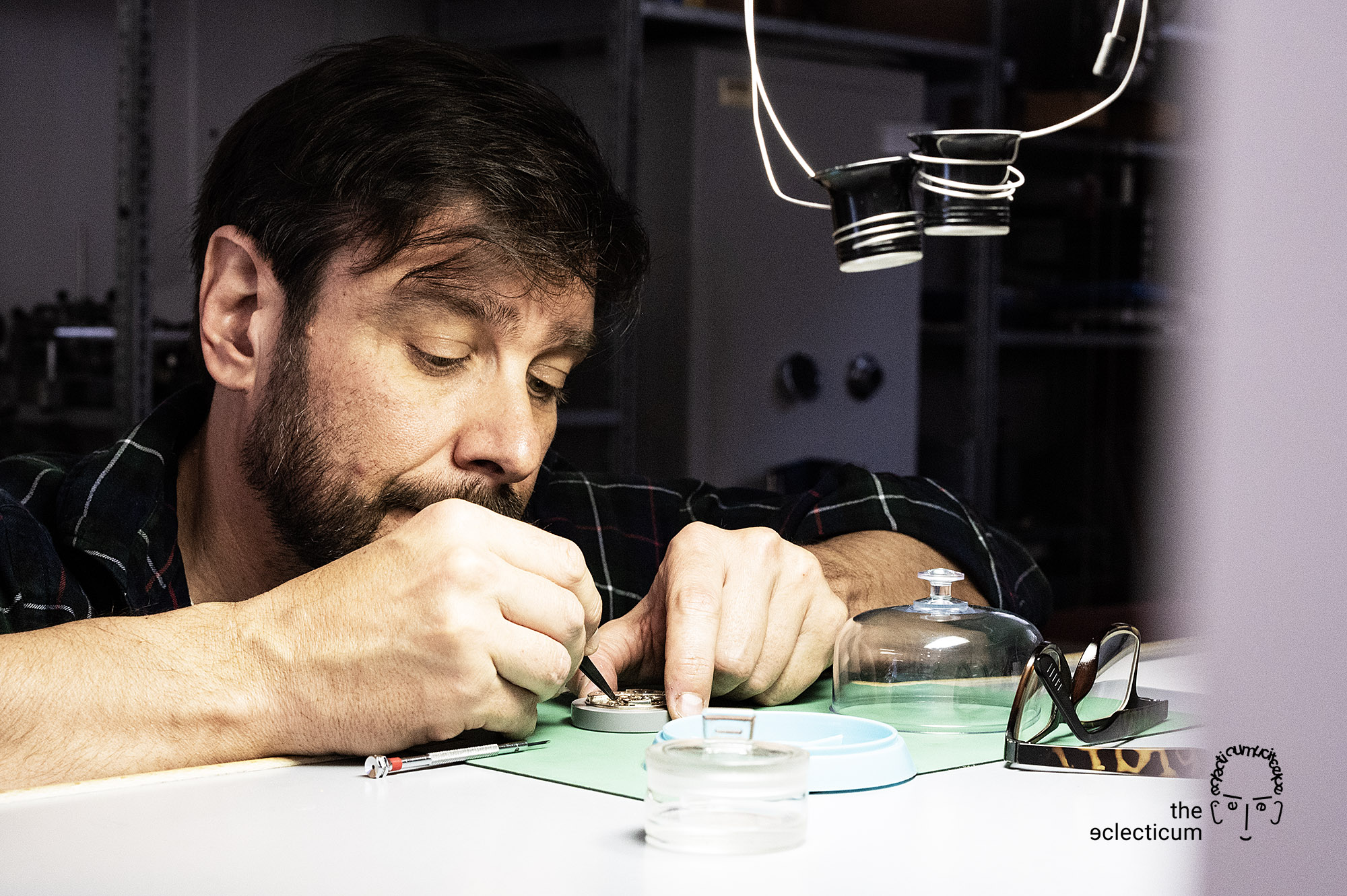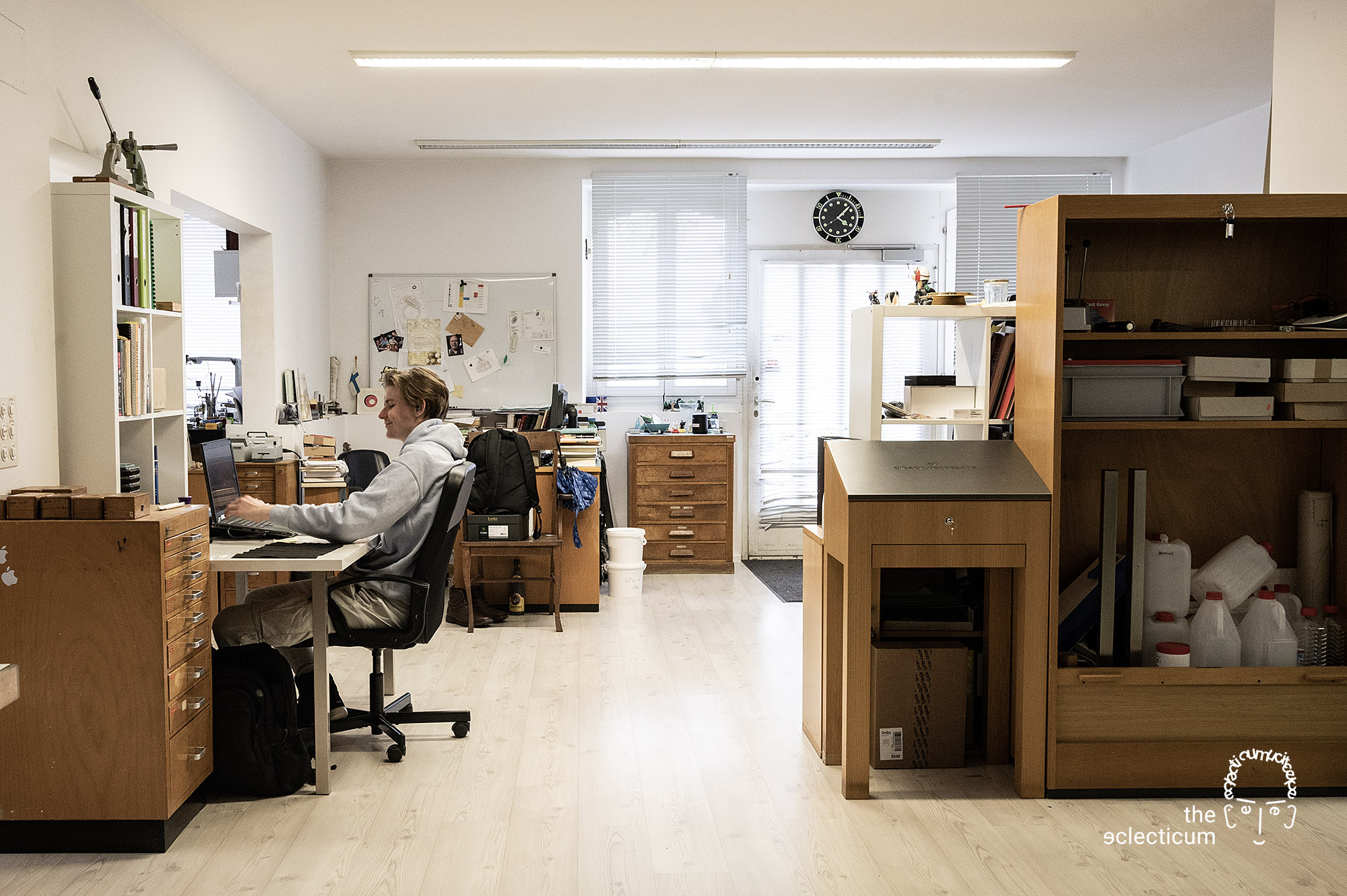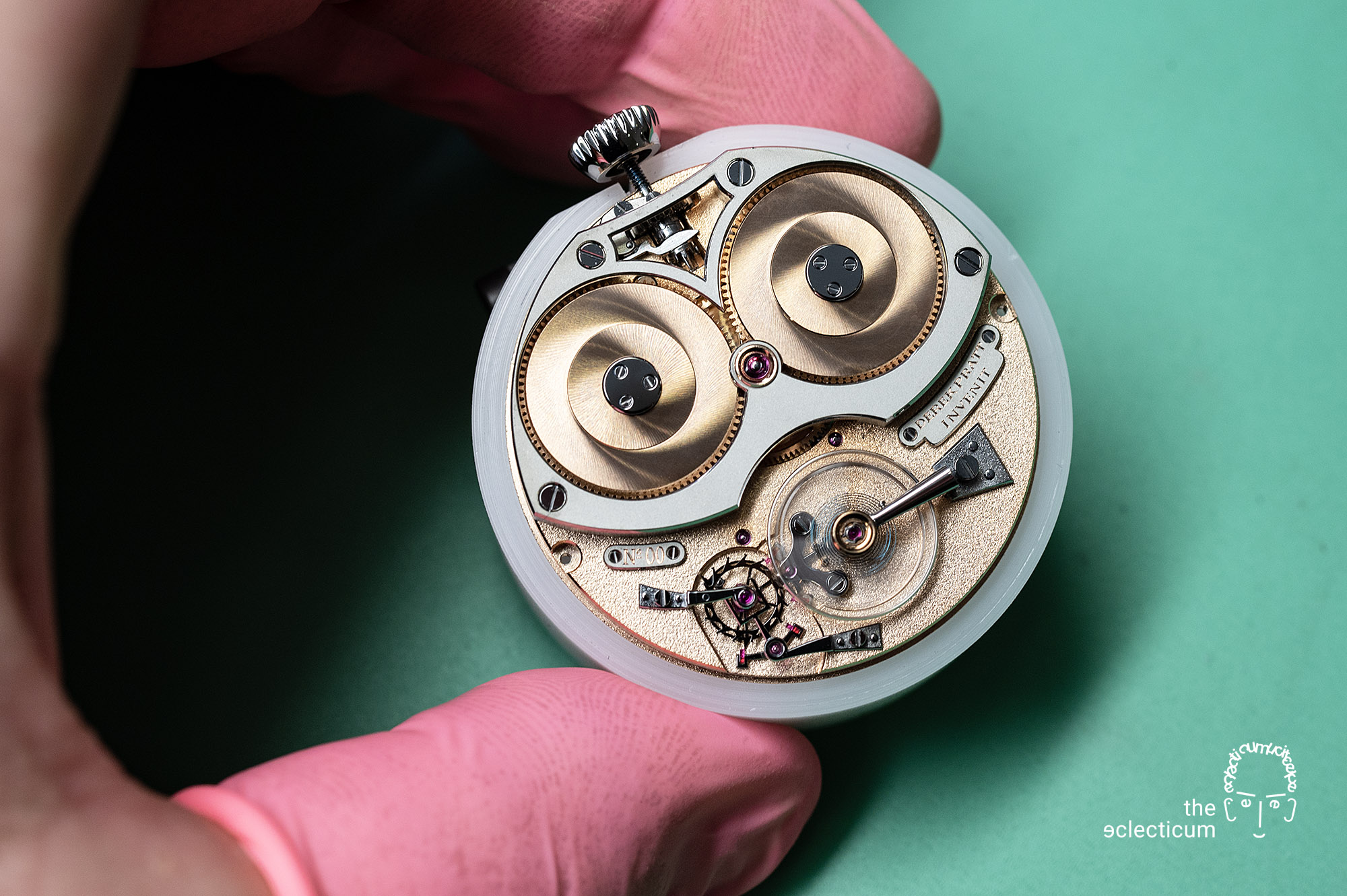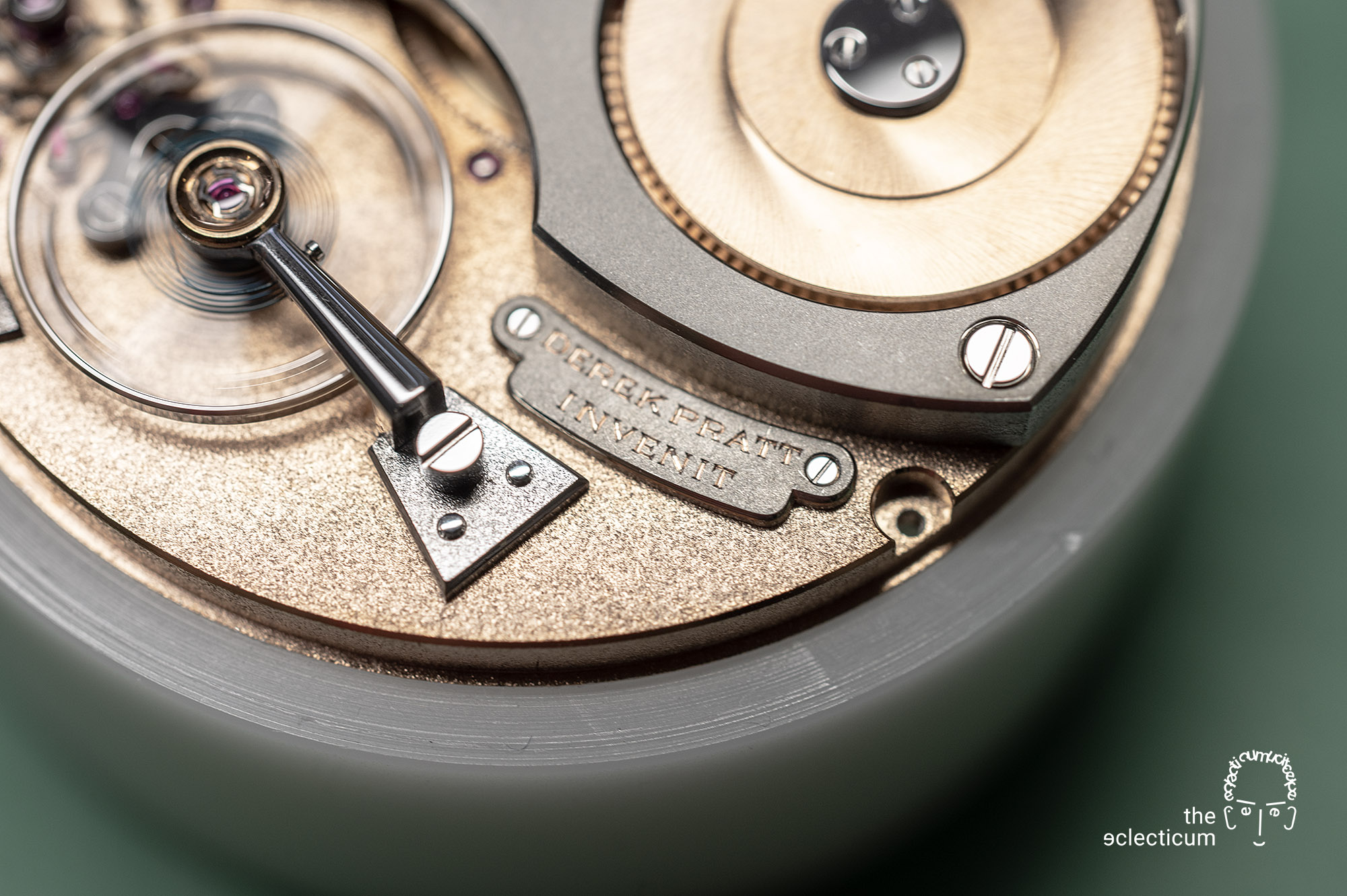written by:
Ornatus Mundi
published:
2023-06-23
categories:
collectors, Derek Pratt, Luca Soprana, watches
When the watchmaker assembles twice – atelier visit with Luca Soprana
Luca Soprana – the gifted artisan and his Atelier 7h38 are a veritable mechanical recluse that helped giving birth to a number of marvels – now they took on to continue Derek Pratt’s legacy
Italian-born Luca Soprana, a fourth-generation watchmaker, is one of those ‘known-unknown’ watchmakers at the very apex of their craft: for many of us, his name rings a bell (quite literally at times…), but then one does not really know where to put him.

So, for starters let’s list (only) a few watches he realised (or helped realising), most of them without his name being on the dial – or even mentioned at all:
- 5 years with Vianney Halter
- Concord Tourbillon Quantum of Gravity C2 (while head of BNB Concept’s prototyping workshop)
- Jacob&Co Astronomia Tourbillon & Epic SF24 split flap 24h watch
- Massena LAB Old School
Most recently however, he made a splash by reviving and continuing the work of the late Derek Pratt (1938-2009), by presenting the Derek Pratt by Luca Soprana (affectionately named ‘Derek’ by Soprana’s team) which is the first ‘serial’ (well, a few handmade pieces) implementation of Pratt’s original remontoir d’égalité.


Derek Pratt was an extraordinary watchmaker who certainly deserves more publicity, and without whom the work of Luca Soprana cannot be fully appreciated, hence a short introduction*:
Side note: Derek Pratt
Being a contemporary of George Daniels, Derek Pratt (1938 – 2009) was the other immensely skilled British watchmaker. Like Daniels, Pratt was fascinated from childhood days by all things mechanical and eventually began a formal training as a watchmaker. From early on he showed tremendous skill and determination, and soon made himself a name in the then tight collector’s circles, particularly for sticking to and perfecting traditional methods to skyrocketing levels (“I prefer CARD over CAD”) for any watchmaking aspect, and for steadfastly working on energy and friction related aspects of escapement (more on that a bit further down).
Unlike Daniels however, he preferred keeping a low public profile which only slightly changed when he teamed up with the late Peter Baumberger to accept the position as technical director of the freshly revived Urban Jürgensen & Sønner firm. He developed several mechanisms for UJS, defined their aesthetics and in particular looked for the ethereally refined guilloche dials. He also created a number of outstanding pocket watches for UJS, such as the Oval No. 1 pocket watch with détente escapement and a remontoir integrated into the tourbillon cage, continuing where Abraham-Louis Breguet stumbled.


The remontoir designed by Pratt sits concentrically on the escape wheel axis and is immediately recognisable thanks to the Reuleaux curved triangle which itself reminds on the construction of Wankel engines (no wonder Derek Pratt drove a Mazda RX-7). With such a construction, the pallets of a fork could be moved laterally but would stay in contact with the triangle cam, providing a constant drag.
One thing which Pratt wanted to try but did not live long enough was to incorporate this remontoir construction into a wristwatch.
 (the Reuleaux curved triangle made of ruby in the Derek Pratt by Luca Soprana remontoir d’égalité)
(the Reuleaux curved triangle made of ruby in the Derek Pratt by Luca Soprana remontoir d’égalité)
This is where Luca Soprana comes in.
If one was to characterise Pratt’s work, then the following comes to mind:
- Tradition, particularly the use of ancient techniques and machines
- Perfection, to the most stubborn degree
- Complexity, even if that impinges on commercial use of a mechanisms
I’ll come back to this later.

Fast forward, to a day in late April this year. I head over to Vaumarcus Castle near Neuchâtel to visit Atelier 7h38 (not sure if that’s the time they start working in the morning or when they close in the evenings, probably both…), the watchmaking workshop of Luca Soprana and his team of 5 watchmaker colleagues. I wanted to understand why ‘Derek’ made such an impression on me.
As soon as the doors open, I cannot help but feel transported well back in time:


This comes as close as possible to a boy’s dream of a place where a medieval alchemist practices his magic. Decades, if not centuries old lathes, jig borers, angling or stamping tools and many more are there in splendid abundance (the youngest machine is a home-made CNC which technically is 15 years old… but all the components except motors and control are from the 1960’s!), and one gets the impression that the computers used there are only little younger.

Vintage (but not outdated) is also the literature the team draws upon. Of course, there is a copy of George Daniel’s ‘Watchmaking’ book, except this here looks really well used. But there was also a book unknown to me, Egidio Garuffa’s ‘Orlogeria Moderna’, an Italian watchmaking compendium which already in detail describes the principle of the remontoir Pratt would ultimately attempt to realise.

Needless to say that I scored my own copy shortly after the visit after a hunt on eBay Italia… Lucky me!
All these machines are not decoration, they are used day to day. Atelier 7h38 does not shy away from modern CNC in principle, but resorts to them only for very limited task, such as to mill out the spokes of gear wheels.
It is immediately obvious that such a workshop cannot produce in serial quantities – at least not in large ones. What is crafted here are handmade timepieces of splendid quality and attention to the detail. I am sure this is not the first time you have heard such a claim, but in this case we find a lot of substance to it.

At a watchmaker’s etabli I noticed a watchmaker assembling what to me looked like another finishing variant of the Derek Pratt Remontoir – with silver instead of the rose gold coloured bridges that the prototype had. Not unusual at a level of this watch that a client would order a few bespoke details.


(movement of the Derek Pratt by Luca Soprana: top, prototype; bottom, a production one in the making)
But I was wrong, as Luca explained: each movement is technically completed and then assembled a first time to ascertain that it functions perfectly and keeps time well before it is finally finished. Only when getting very close and using my loupe I noticed that the parts were not yet in their ultimate state – so well is the machining and the pre-finish done (and the watchmaker was quite proud already of this!).

 (balance cock finishing: top, pre-finished; bottom, finished cock)
(balance cock finishing: top, pre-finished; bottom, finished cock)
Checking the performance of a movement not only has workflow advantages (one spends the time-intensive handwork only on parts that deserve it), but this also ensures that eventually necessary adjustment measures leave no traces on the bridges.
Speaking of finishing, it is of course at an exceptional level and done entirely by hand. Luca showed me custom wheel holding tools which enable a watchmaker to bevel wheel spokes with considerable depth. I was stunned enough by this example that I forgot to take a picture…
Each completed movement offers insights which are implemented in the following ones, and as consequence parts are often not interchangeable between individual movements. To illustrate this Luca pointed me to the supporting bridges of the remontoir mechanism on the dial side. If one compares the prototype with the movement currently being assembled the differences are clear, with the new layout offering ease of positioning and more stability on the adjustment.
 (movement of the Derek Pratt by Luca Soprana, dial side: left, prototype; right, a production one in the making. Note the heat blued hardened barrel wheels, the blue will be brushed off still. Take also note on the different remontoir support bridge assemblies at 7 o’clock!)
(movement of the Derek Pratt by Luca Soprana, dial side: left, prototype; right, a production one in the making. Note the heat blued hardened barrel wheels, the blue will be brushed off still. Take also note on the different remontoir support bridge assemblies at 7 o’clock!)
Perfection! Oh wait, there is something really fascinating to show: please take a close look at the screw heads that fix the bridges:

Notice the slots are all arranged with a defined angle? This is not coincidence or a feature of the prototype, this is deliberate. Atelier 7h38 turns their screws themselves, and adjust the length of each screw individually such that when mounted the slots look well arranged (comparable effort on screw finishing are only known to us, at least, from Marco Lang) … what an effort spent on such a minuscule detail!
Also the hair springs are finished in the atelier, i.e., they come raw from a specialist supplier and then at Atelier 7h38 are individually bent to perfection and ultimately heat blued. Note how they are flat like a mirror:


And I am not the least surprised that the espresso served is close to perfect as well (although Luca apologised for not yet having finalised the ultimate grinding grade of the beans… one reason more to return!):

So let me recall the characteristics of Derek Pratt’s watchmaking: tradition, perfection, and complexity – all three items are here as well, and with exactly the same qualification that I noted further above. As such, I think, this is the exact reason why Jenny Pratt, Derek’s widow, entrusted the realisation of her late husband’s dream to the team around Luca Soprana. Luca told me that Jenny is very closely overseeing the progress and offering her suggestions and criticisms (and at times her veto as well).

Side note: The watch shown here isn’t the first attempt to bring Derek Pratt’s Remontoir to life on the wrist as there was one initiated and supervised by two gentlemen from the US. This one however was missing ´the extra mile` Derek was known for – at least in our book. Dial, hands and the case kept us lukewarm. To us it felt more like a ´homage on a budget` and we don’t even talk about trademark issues and so on. The only reason to mention this is to understand that not every project – even with highly talented people involved – leads to success or even better to an adorable ´object of beauty` that happens to be a watch for the wrist of true connoisseurs.
Which at the end addresses my concern that the name of a renowned watchmaker is exploited for commercial objectives. Here (now!), there is a logical and consistent continuation – almost like Derek Pratt 1.1 or even 2.0 and the outcome is worth to get all the merits on its own!
Ornatus Mundi



____________
*) We can’t attempt to provide a comprehensive presentation of Derek Pratt’s work and personality, instead we cordially invite you the read the following resources:
- Russell Sheldrake’s intimate homage over at A Collected Man
- for solid context the book: Derek Pratt – Watchmaker, British Horological Institute (2012; reprinted 2014 and 2018)


